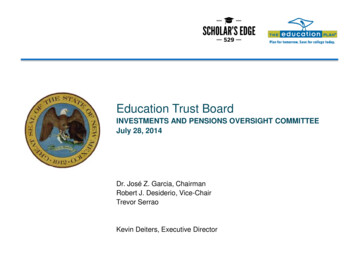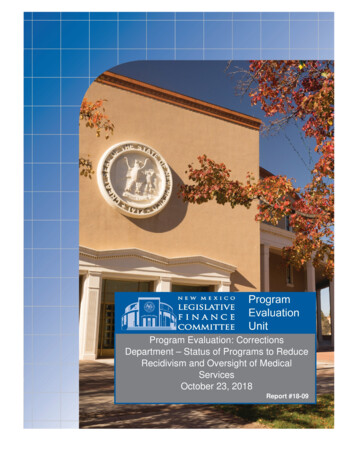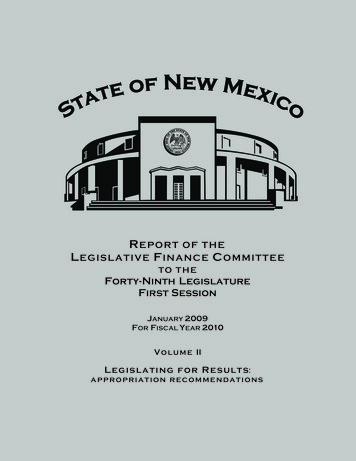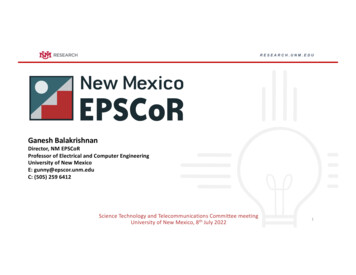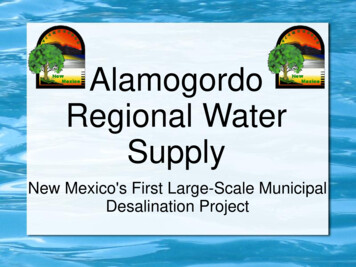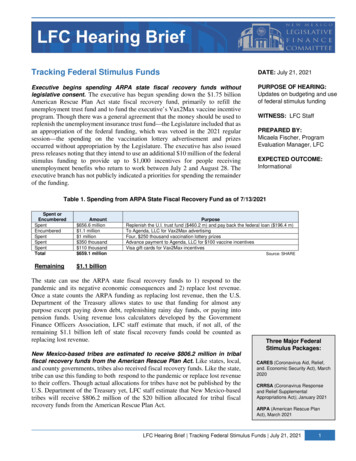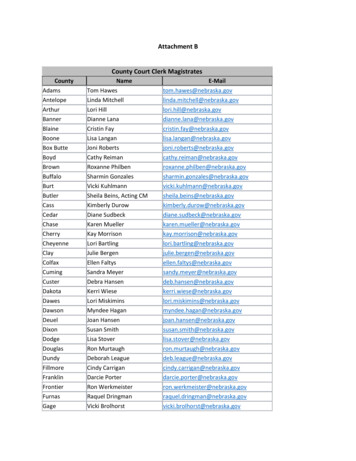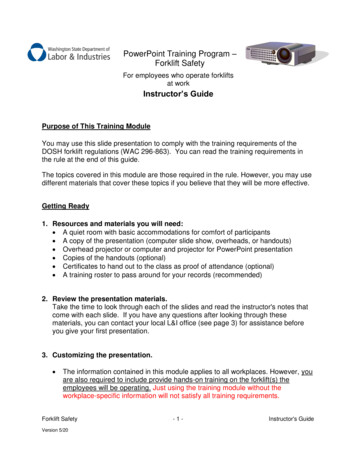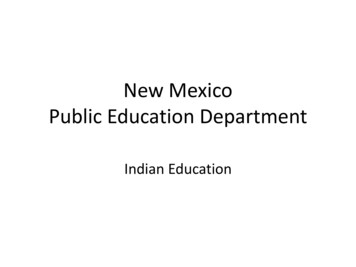
Transcription
New MexicoPublic Education DepartmentIndian Education
States with Highest Percentage ofAmerican Indian Student PopulationsSelected anaSouth DakotaNew MexicoNorth DakotaArizonaWashingtonMinnesotaOregonUtahNorth CarolinaAI/AN as percent of statetotal 42
American Indian Students in NM Enrollment: 34,925 American Indian Studentsin 843 public and charter schools (NM 856schools in 89 districts) Total BIE Schools: 24 Total Tribal Contract or Grant Schools: 17 Largest tribal student representation: Navajo,76.6% 23 tribes/pueblos in NM, 10 languages in 4language groups3
Educational Programs TargetingAmerican Indian Students Three federal programs generate funds for American Indian students andare used for educational programs specifically for American Indian (AI)students –– Title VII, Indian Education Formula Grants to Local Education Agencies School Districts apply directly to U.S. Dept. of Education forproviding educational services based on student needs; 7.3m distributed to 15 districts and 20 tribal schools in NM forschool year 2010-11 .– Title VIII, Impact Aid Funding from the U.S. Dept. of Education for basic operationalcosts to replace local tax revenues not received because of federalor tribal lands - 254.m to 18 school districts; Funds typically go directly to school districts based on AI studentnumbers, however, NM is an equalization state which dividesrevenues that equalizes spending among districts across the state. 4
Educational Programs TargetingAmerican Indian Students– Johnson O’Malley Funding from the Bureau of Indian Education for public schoolshaving large AI student populations for supplemental educationalservices – 2.2m to 12 school districts NM Indian Education Act– 1.3m provided in grants to NM tribes, schools, and special set-asides Only four districts receive all four funding sources.5
NM Indian Education Act (IEA)Grantees Tribal Grantees, 425,000 Tribal language grants toensure the maintenanceand revitalization of nativelanguages. Grant amountsvaried depending on whatthe language programidentified as needing tocontinue working on theirtribal initiatives for thefiscal year. 2011 Grantees (8):––––––––Pueblo of IsletaPueblo of CochitiPueblo of San FelipePueblo of TaosPueblo of Santa ClaraMescalero Apache TribePueblo of SandiaPueblo of Santo Domingo6
NM IEA Grantees Exemplary Grantees, 200,000 – Collaborations between the schooldistricts, local Pueblos and native communities, to establish a frameworkof best practices for replication for Indigenous students. 2011 School Grantees (8) (District):– Laguna-Acoma High School (Grants-Cibola)– Los Alamitos Elementary School (Grants-Cibola)– Mescalero Apache School (BIE)– Milan Elementary School (Grants-Cibola)– Mt. Taylor Elementary School (Grants-Cibola)– Walatowa Charter School (Jemez Valley)– Dowa Yalanne Elementary School (Zuni)– Cochiti Elementary School (Bernalillo)7
NM IEA Grantees Save the Children, 300,000 - Rural literacy initiative to support afterschool and summer literacy block programs for students in kindergartenthrough eighth grade in schools with a high proportion of American Indianstudents contingent on receipt of 300,000 in matching funds from otherthan state sources. Sites (9):– Cubero Elementary (Grants-Cibola)– San Diego Riverside Charter (Jemez Valley)– Thoreau Elementary (Gallup-McKinley)– Church Rock Academy (Gallup-McKinley)– Crownpoint Elementary (Gallup-McKinley)– Tohatchi Elementary (Gallup-McKinley)– Twin Lakes Elementary (Gallup-McKinley)– A:shiwi Elementary (Zuni)– Dowa Yalanne Elementary (Zuni)8
NM IEA Grantees Teaching Support, 400,000 - For a nonprofit organization that providesteaching support in schools with a high proportion of American Indianstudents. The current funding is contracted with the Teach for Americanonprofit organization. They are currently providing teachers and workingwith 4 major districts within the northwest region of the state. School Districts (4):– Central Consolidated School District– Gallup-McKinley County School District– Grants-Cibola County School District– Zuni Public School District9
Teach For America (TFA) Focus services in low-income communities and lowperforming schools with the least capacity to serve childrenwith the greatest needs. TFA teachers set ambitious, measurable goals for students tomake significant academic growth (on average 2 years growthor more). Currently there are over 125 TFA corps members that aredirectly impacting the lives of more than 7,000 students inNew Mexico. Sixty-one percent of Teach For America corps members teachbeyond their two-year corps commitment.10
Save the ChildrenNational Results for Literacy Program: Children showed major improvement afterparticipating in the literacy program. To provide additional reading support, staffmembers work with select groups of strugglingreaders during the school day to provide tutorialsin phonics, sight word growth, comprehensionand vocabulary enhancement. Emergent readeractivities are also available for children inkindergarten and first grade.11
NM American Indian Students Of the 89 school districts, 23 districts are locatedon or near a reservation. Many of the districts with high American Indianstudent populations are among the moststruggling schools in the state. The majority of school districts with largenumbers of American Indian students are in thenorthwest area of NM.12
American Indian Student PopulationsSchool Districts On or Near .50%13ZuniTularosaTaosSanta FeRuidosoRio RanchoPojoaquePenascoMagdalenaLos LunasJemez ValleyJemez tral Cons.BloomfieldBernalilloAztecAlbuquerque0.00%
23 School Districts On or Near ldCentral Cons.CubaDulceEspanolaFarmingtonGallupGrantsJemez MountainJemez ValleyLos LunasMagdalenaPenascoPojoaqueRio RanchoRuidosoSanta 84.0075.04Percentage of American Indian Students Below ProficiencySchool Year 2009-10 AYP14
School Districts On or Near ReservationsPercentage ofAmerican Indian Students Proficient and AboveSchool Year 2009-10 AYP0.00AlbuquerqueAztecBernalilloBloomfieldCentral Cons.CubaDulceEspanolaFarmingtonGallupGrantsJemez MountainJemez ValleyLos LunasMagdalenaPenascoPojoaqueRio RanchoRuidosoSanta 9642.8815
NM Grad .8%50%56.2%60%60.3%70%AllHispanicAm. Ind.30%20%10%0%20082009201016
Impact of School GradingSchool Grading will – Allow districts to make and get credit for progressin student performance rather than the currentAYP structure -- a ‘pass or fail’ system. Be easier to understand. Be easier to convey to parents and communities. Provide a tool to engage parents andcommunities. Allow us to target resources where they areneeded.17
Teacher Effectiveness There is little correlation in the currentteacher evaluation system to the effectivenessof their teaching. 99.986% of all teachers in NM are currentlyrated as ‘effective’. Yet, student performance indicates that asignificant percentage of American Indianstudents are performing below the proficientlevel.18
Impact of a New Teacher EvaluationSystem Changes in the teacher evaluation system canfocus on individual improvements of studentsand the effectiveness of teachers. Incentives and rewards for effective teacherswill assist rural schools in retaining effectiveteachers. Identifying teachers who are effective shouldresult in marked improvements in studentperformance.19
PED Focus for Indian Education IEA focus on funding programs proven to beeffective based on supporting studentachievement data. Distribution of proven and effective programpractices directly supporting schools, districts andcommunities. Coordinated and aligned services from all PEDprograms for low performing school districts. Closer collaboration with BIE for supporting tribalschools.20
PED Focus for Indian Education Closer collaboration with pueblos and tribes andthe school districts serving tribal students. Collaboration with other states having significantAmerican Indian student populations on effectiveprograms and strategies. Form partnerships with other stakeholders andseek additional resources and funding. Redefine the structure and services of the IndianEducation Division within PED to better providefor American Indian students.21
American Indian Students in NM Enrollment: 34,925 American Indian Students in 843 public and charter schools (NM 856 schools in 89 districts) Total BIE Schools: 24 Total Tribal Contract or Grant Schools: 17 Largest tribal student representation: Navajo, 76.6% 23 tribes/pueblos in NM, 10 languages in 4 language groups 3
